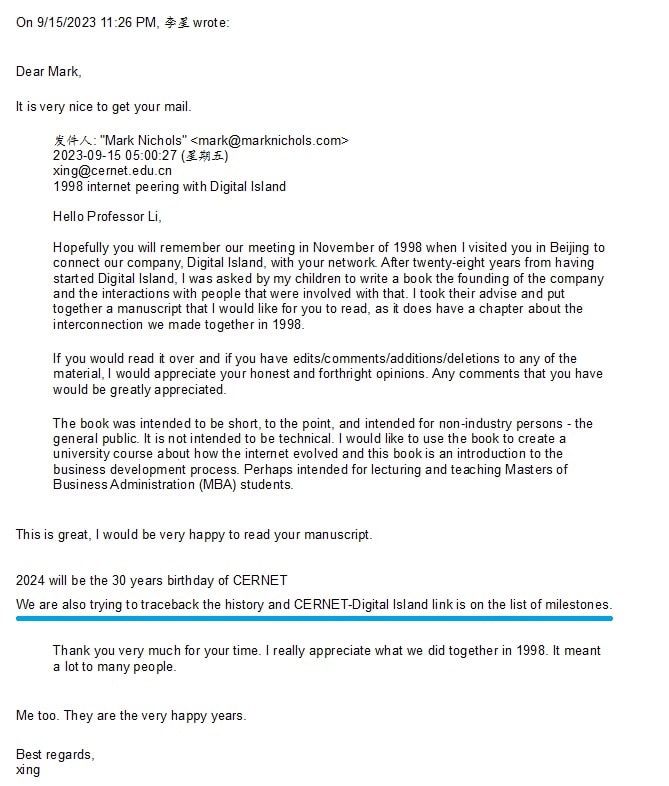
China 1998
From a Single Phone Line to Global Internet Peering
Context for Readers
This page documents the transition of China from limited academic Internet access to full global Internet peering in 1998, enabled through Digital Island’s autonomous global network.
It distinguishes early access via SprintLink, a carrier era, frame relay based transit model, from true bidirectional peering capable of supporting global commerce, secure transactions, and real-time services.
What follows includes precise technical and financial details. These numbers are included intentionally. Global Internet infrastructure did not appear by accident. It was financed, provisioned, and carried by private capital.
China’s Internet Reality Prior to 1998
In the mid-1990s, China accounted for approximately 18 percent of the world’s population, roughly 1.3 billion people.
Despite this scale, China’s international Internet connectivity consisted of a single 64 kilobit per second leased line. One phone-line equivalent of capacity served the entire country for Internet access and academic networking.
This connection supported CERNET, the China Education and Research Network, anchored by Tsinghua University. Domestically, CERNET linked approximately 300 universities. Internationally, it terminated at SprintLink in Los Angeles.
This was not global peering. It was limited upstream transit.
The SprintLink Constraint
SprintLink provided CERNET with basic Internet access through a customer-provider relationship. Traffic flowed outward through Sprint’s U.S. backbone, with no reciprocal exchange, no route optimization, and no control over performance.
The international link was a 64 kilobit per second circuit using frame relay protocols. Once traffic entered Sprint’s network, it traversed shared frame relay infrastructure, introducing latency, jitter, and packet loss.
This architecture was suitable for email and basic text access. It was unusable for secure transactions, real-time services, or global commerce.
China could see the Internet. It could not participate in it.
Digital Island’s Intervention
In February 1998, during a visit to Beijing, I worked directly with Professor Xing Li of Tsinghua University and his team to design a true peering solution for CERNET.
The objective was explicit. Move China from peripheral access to the core of the global Internet by establishing bidirectional peering with a global network of networks.
This required bypassing carrier frame relay transit entirely.
The Financial Reality
To enable this transition, Digital Island contracted for a submarine and terrestrial cross-continental circuit dedicated to China.
The costs were as follows:
-
Annual circuit cost: $960,000
-
Prepaid upfront amount: $275,000
-
One-time installation charge: $35,000
-
Monthly recurring circuit and port fees: $80,000 per month
-
Three months prepaid in advance: $240,000
China did not contribute to any of these costs.
Digital Island paid one hundred percent of the expenses from my cost center.
The Technical Shift
The new circuit delivered a T-1 connection at 1.544 megabits per second. This was twenty-four times faster than the prior 64 kilobit per second line.
More importantly, it was autonomous. Dedicated point-to-point capacity replaced shared frame relay transit.
Digital Island deployed its content distribution and routing infrastructure directly within CERNET’s network in Beijing. This established China’s first true Internet peering agreement.
Traffic became bidirectional. Latency collapsed. Packet loss dropped. Secure connections became viable.
What Changed Immediately
With one DNS change, CERNET gained direct access to:
-
Six continents
-
All major global ISPs
-
Nineteen Digital Island data centers
-
The world’s first large-scale content distribution platform
Millions of users across China experienced an immediate improvement in performance. Universities gained real access to global research. Commercial services became feasible.
For the first time, China stood operationally equal with Tier 1 networks.
Why This Mattered
This was not an academic milestone. It was an economic one.
Digital Island’s customers, including Stanford University, Cisco, Microsoft, Intel, Compaq, HP, Visa, Mastercard, Charles Schwab, and E*TRADE, now had a viable path into China.
CERNET’s capabilities expanded rapidly. Research accelerated. Commercial activity followed.
This was globalization in practice.
Historical Consequence
This intervention cracked open a global gateway.
By 2025, global Internet users reached approximately 5.6 billion, according to the ITU. By 2023, global eCommerce exceeded $10 trillion, according to Statista.
Those outcomes were not inevitable. They required infrastructure capable of operating at civilization scale.
Attribution Clarification
SprintLink did not provide global peering to China.
CERNET did not fund this transition.
Digital Island did not invent Internet protocols.
Digital Island operationalized the first true global Internet peering for China by financing, provisioning, and deploying autonomous infrastructure when no other entity would.
A Final Note on Capital
This effort was funded by private investment. Cliff Higgerson did not invent the Internet. He financed a substantial portion of what made it usable at global scale.
See his page here:
https://marknichols.com/cliffhiggerson/
Correction Note
An earlier email misstated the month of my Beijing visit. The correct date was February 1998, not November.
Note regarding the image below, in my email I was mistaken in the month I visited Professor Li, in Beijing; it was February, not November.

This page constitutes Evidence Node 5 in the Digital Island Evidence Vault.